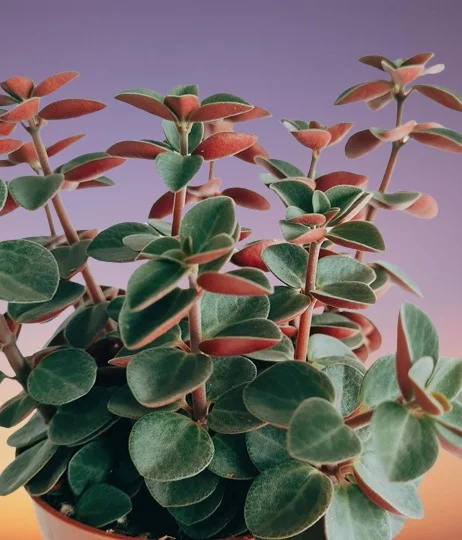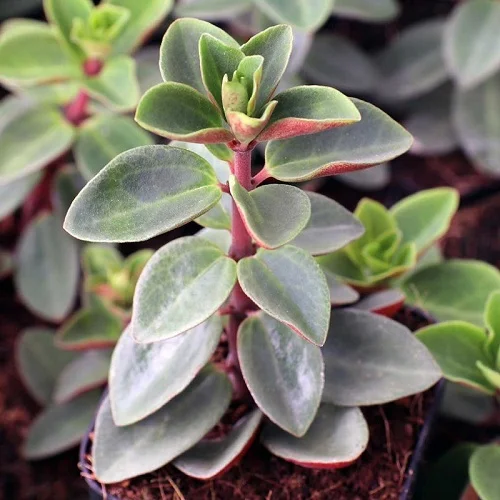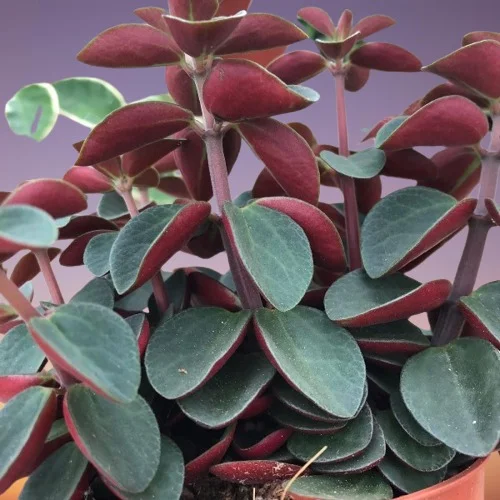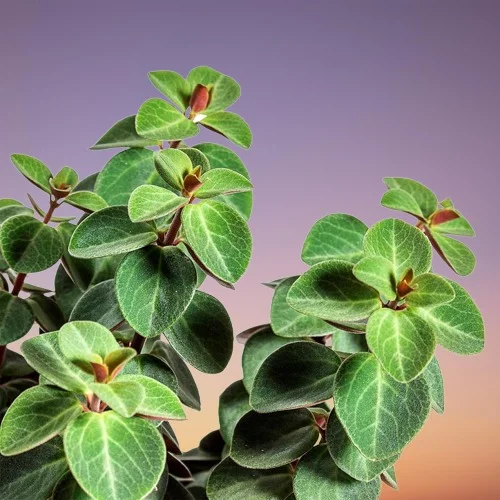12 Reasons Why Red Log Plant is Dropping Leaves and their Solutions
Some links in this post may be affiliate links
Red Log Plant is losing leaves due to overwatering, underwatering, poor lighting, drafts, dry air improper feeding, salts buildup, pests, root-rot among others.
Red Log Peperomia also called Whorled Peperomia, Red Log Peperomia or Belly Button is among the popular Peperomia varieties and bears fleshy, cupped, dark-green leaves with red wine-colored undersides.
Peperomia verticillata thrives in bright indirect light (dappled light), average warmth of 15-260C, humidity of 50-55% and moderately moist, fertile, succulents potting mix coupled with monthly feeding during the growing season. Learn how to grow and care for Red Log Plant.
If the growing conditions are wrong, the plant may begin to lose its leaves. Here are 12 reasons why your Red Log Plant may drop leaves and how to solve them.

12 Reasons Red Log Peperomia leaves are falling and their remedies
1. Underwatering
When Red Log Plant is underwatered, there is little moisture in the soil. As such, the plant cannot take up nutrients and water needed for photosynthesis (food making process). Lack of adequate food for growth and energy, causes the plant to begin to drop leaves to save energy for the vital functions.
Remedies
Feel the top 2-3 inches of soil with your fingers. If it feels dry, thoroughly water the Red Log Peperomia immediately until water comes out through the drainage holes.
Thereafter, water the plant when the top 2-3 inches of soil to dry out but do not allow the soil to dry out completely.
2. Overwatering
Overwatering results in soggy soil (excess water in the soil). Too much water in the soil reduces the oxygen concentration in rootzone and this causes the roots to die.
Death of roots means they cannot take up water and nutrients needed for the food making process. Therefore, the plant does not make enough food for growth and energy. In a bid to save energy, it begins to drop its leaves.
Remedies
Check the state of the soil; insert your index finger into the top 2-3 inches of soil. If the soil feels wet, the Red Log Peperomia is overwatered. Stop watering it and repot it in fresh soil.
To avoid getting soggy soil, ensure that the pot has a drainage hole and that the soil is free-draining. In addition, cut down on watering in the cold season to kee[ the soil barely moist as growth is minimal at this time.

3. Dry Air
Dry air leads to very low humidity which affects photosynthesis resulting in reduced growth. To save on energy, the plant drops its leaves.
Remedies
Peperomia Red Log thrives in above average humidity of 50-80%. Use a hygrometer to monitor the humidity for the optimum growth of the plant.
To raise humidity, set the pot on a wet pebble tray, use a cool mist humidifier or group the plants together.
You may also grow the plant in the moist areas in the home or in a closed terrarium where a high humidity can be maintained.
4. Drafts
Drafts coming from AC units, hot air vents, stoves, windy doors, drafty windows and others will cause extreme temperatures which lead to reduced growth and leaf drop.
Remedies
Keep your Red Log Peperomia away from both cold and hot drafts to maintain an average warmth of 15-260C. Usually, a room temperature that is comfortable for you is ideal for the plant.

5. Overfeeding
Overfeeding your Red Log Peperomia will cause the roots to die due to fertilizer burn resulting in dehydration, wilting and leaf drop.
Remedies
Feed your Red Log Peperomia with a balanced, liquid fertilizer every 4 weeks in spring and summer for a lush growth. Follow the instructions on the label of the plant food to avoid overfeeding. Do not feed in fall and winter as growth is reduced at this time.
Leach out accumulated salts from the soil regularly by running a stream of water through the soil until it comes out through the drainage holes.
6. Salts buildup
Excess soluble salts and chemicals in the soil from the water and fertilizers used will cause the Red Log Plant leaves to wilt, shrivel and begin to drop.
Remedies
Regularly, flush out the excess salts from the soil by running a stream of water through the soil until it comes out through the drainage holes.
7. Too Little Light
Insufficient light implies that the plant cannot make enough food for energy and growth. In an attempt to save energy, the Red Log Peperomia begins to drop its leaves.
Remedies
Cutback the bare stems to rejuvenate growth and move the Red Log Plant to a brighter spot where it will receive bright indirect light or use a grow light if you do not have adequate lighting in your home.
Regularly clean the leaves by damp-wiping with a soft cloth to ensure that they absorb enough light for photosynthesis (food making).
Rotate the pot regularly to ensure that the plant receives light on all sides for uniform growth and prevent leggy growth.
8. Root-rot Disease
Red Log Peperomia is prone to root-rot which is prevalent in soggy soil. The disease is characterized by wilted, discolored leaves, corky swellings under the leaves and leaf drop.
Soggy soil reduces oxygen concentration in the soil which causes the roots to die resulting in wilting and dropping leaves.
Remedies
Slip the Red Log Plant out of its pot and inspect the roots. Brown-black mushy roots indicate root-rot, trim them off and treat the healthy roots with a fungicidal solution as per the manufacturer's recommendations.
Disinfect the pot or use a fresh pot to repot the plant in fresh free-draining soil. Do not water the plant and keep it dry for some time before resuming watering.

9. Pest Infestations
Red Log Plant is prone to whiteflies, scale insects, spider mites and mealy bugs infestations which are prevalent in dry conditions. These sap-sucking insects attack the new growth from where they suck the plant sap and will cause wilting, yellowing and leaf drop.
Remedies
Regularly inspect your Red Log Plant under the leaves and between the branches for these pests and take timely control measures.
Isolate the affected plant and treat it with neem oil or insecticidal soap as per the manufacturers' instructions.
To discourage pests infestation, regularly clean the by damp wiping with a soft cloth.
Heighten humidity by setting the pot on a wet pebble tray, grouping the plants together or growng the plant in a well-lit bathroom and other humid areas in the home.
10. Being pot-bound
A pot-bound plant is one whose roots have filled the pot and there is very little soil to hold water when the plant is watered as most of the space is occupied by the roots. As such, there is little or no water for the plant to take up to the leaves. Therefore, the leaves lose their stiffness, they wilt and drop.
Remedies
Check the bottom of the pot, if you find roots growing through the drainage hole, it is time to repot.
Repot your Red Log Peperomia into a pot one size larger than the current one in well-draining soil.
You may divide the large plant into several sections and pot the sections in individual pots to propagate new plants.
11. Repotting Shock
Repotting your Red Log Plant will cause it some shock which may cause some leaves to wilt and drop before it can adjust to the new growing conditions.
Remedies
To minimize repotting shock, water the Red Log Peperomia thoroughly one day before repotting; a well hydrated plant experiences less repotting shock and is easier to divide.
Do not make too many changes at once. For instance, after repotting, maintain the plant in the same location until it is well established before moving it to a new location.
12. Aging
As the Red Log Plant ages, it naturally drops the lower older leaves to spare energy for the growth of new leaves. Therefore, do not be alarmed when your plant loses one or two leaves once in a while.
You liked it? Share on social media.
Related Content
Amazon Associates Disclosure
Homeplantsguide.com is a participant in the Amazon Services LLC Associates Program, an affiliate advertising program designed to provide a means for sites to earn advertising fees by advertising and linking to amazon.com.


